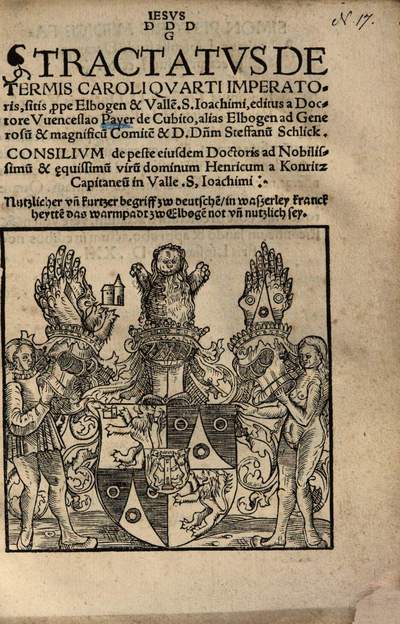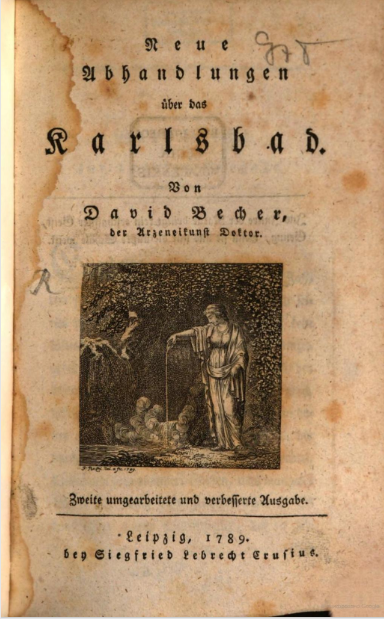The history of Karlovy Vary treatment: from Celts to lasers

The Celts were the first to discover the hot springs in Karlovy Vary. They were mining metal in settlements nearby and noticed that the river Tepla does not freeze over in winter. Observing and exploring, they came across several hot springs near the confluence of the Tepla and Ohře rivers.
The exact date of the founding of Karlovy Vary is unknown. In 1325, the king of Bohemia, John of Luxembourg (also known as John the Blind), annexed the lands of the settlement of Obora to the settlement of Vary and ordered the residents of the former to move closer to the hot springs. It was in this decree that the first written mention of Vary appeared. The next ruler of Bohemia, Charles I, known in Europe as Charles IV of Luxembourg, had a weakness for the settlement. Here, he healed wounds received in the Battle of Crécy. In 1358, he granted the settlement privileges and the status of a city. In the following decades, towers, castles, thermal baths were built, some of which have survived to this day, for example, the hunting castle (castle tower). It was then that the city began to be called King Charles's baths or Karlovy Vary (Karlsbad in German).
The hygiene standards of the 14th century would shock a modern person. Even among the nobility, dirt was a common occurrence, fur and silk clothing were rarely washed, if at all. The body was constantly subjected to bites from fleas, lice, bedbugs, and other insects. Various rashes, scabies, and chronic inflammatory processes on the skin. All these factors led to the phenomenon of cutis vagantium - the skin of a vagabond. This is why bathing in thermal water lasted for many hours, the skin became soft and cracked, and it was believed that "harmful substances" leaked out through the cracks. The nobles sat for hours in the baths discussing their noble affairs with a glass of wine, while common people bathed in natural pools. In warm water, joint injuries or wounds were successfully treated, back and limb pain subsided, and muscles and tendons stopped hurting.
 By the 16th century, the "rating" of diseases had significantly changed. Living conditions had improved, and more was known about the importance of hygiene. Skin infectious diseases were replaced by gastrointestinal diseases caused by improper and excessive nutrition. Constipation, diarrhea, and intestinal worms were first written about by Dr. Václav Payer in 1522. At about the same time, an epidemic of syphilis swept through Europe, which was severe with terrible fever and rash, causing people to avoid public baths. There was a need to change treatment methods to more private ones. Thus, drinking treatment replaced bathing.
By the 16th century, the "rating" of diseases had significantly changed. Living conditions had improved, and more was known about the importance of hygiene. Skin infectious diseases were replaced by gastrointestinal diseases caused by improper and excessive nutrition. Constipation, diarrhea, and intestinal worms were first written about by Dr. Václav Payer in 1522. At about the same time, an epidemic of syphilis swept through Europe, which was severe with terrible fever and rash, causing people to avoid public baths. There was a need to change treatment methods to more private ones. Thus, drinking treatment replaced bathing.
Obviously, for 200 years, people had been trying to drink water from springs. Some felt better, some worse, and there was a lack of scientific approach and systematization of observations. This is what the aforementioned Dr. Payer from the University of Leipzig did. He outlined the scientific basis of taking thermal water in Karlovy Vary in his Tractatus de termis Caroli quarti Imperatoris, sitis, prope Elbogen et +& vallem S. Ioachimi - "Treatise on the Baths of Emperor Charles IV, located near Elbogen and the Valley of St. Joachim". The experience of drinking Carlsbad water, described in the treatise, was based on decades of observations and information gathered by the doctor from colleagues who had studied the issue since the 15th century.
Dr. Payer suggested alternating between days of drinking treatment and days of bathing. Daily water intake with increasing portions caused stomach upset, and the treatment course required breaks. At the same time, daily bathing irritated the skin and also required pauses. The most effective treatment course was to have 5-6 days of drinking treatment followed by 2-3 days of bathing, and the total treatment duration was at least four weeks, including 3-5 such cycles. The water was taken immediately after sunrise, applying the so-called pyramidal treatment. Its essence was to start treatment with the intake of 200 ml of water per day and increase it to an impossible 50 glasses per day (about 10 liters), then gradually reduce it back to one glass per day. The criterion for the effectiveness of stomach treatment was 2-3 acts of defecation before noon time. Baths were prescribed less and less frequently until in the early 17th century, the respected Dr. Strobelberger excluded them from the treatment course altogether. To be fair, the same Dr. Strobelberger published a work in 1630 about dental worms, which he proposed to treat with sulfuric acid and a decoction of frogs. But that's a completely different story.
Today, 10 liters of mineral water per day seem like a harmful dose. Such an amount of water relieved constipation, but the side effect was severe stomach upset. Not the best replacement, right? Nevertheless, severe diarrhea reduced the population of intestinal parasites, and even eliminated some completely. It is for this reason that such a radical option for drinking treatment lasted almost 200 years. It is also worth noting that Dr. Payer himself noticed a pattern in the first half of the 16th century: the saltier water one drinks, the more edema and the more difficult it is for the heart to cope with the load. He said about the intake of a large amount of water: "For heart palpitations, it's poison". Doctors of those times knew that such an amount of water overloads the cardiovascular system, kidneys, urinary tract, especially if they are narrowed by urolithiasis, scars, prostatitis.
 Another person who had a strong influence on the treatment in Karlovy Vary was Dr. David Becher. He is called the Hippocrates of Karlovy Vary and is considered a pioneer of modern balneological treatment. He began working as a resort doctor in 1752 and made many important innovations in the Karlovy Vary traditions of drinking therapy over his career. Firstly, Dr. Becher reduced the daily water intake from 10-12 liters to 1.5-2 liters, taken in the mornings. Secondly, he began prescribing water not only from the Hot spring, but also from the Castle, Mill, Rusalka (Mermaid), and King Wenceslas springs. Thirdly, Becher actively researched the chemical composition of the water, discovered the property of carbon dioxide to evaporate quickly, and as a result, suggested drinking water directly from the springs. Thanks to him, the healing properties of carbon dioxide began to be actively studied by scientists, and over the years, carbon dioxide baths, dry carbon envelopes, and later gas injections became an integral part of every treatment program in Karlovy Vary. Fourthly, Becher actively promoted the benefits of walking in the forests of the resort, as well as supporting drinking therapy with a diet. Dr. Becher made spa treatment attractive to the masses. The result of his work was the book Neue Abhandlungen über das Karlsbad - "New Treatises on Karlovy Vary", published in 1766.
Another person who had a strong influence on the treatment in Karlovy Vary was Dr. David Becher. He is called the Hippocrates of Karlovy Vary and is considered a pioneer of modern balneological treatment. He began working as a resort doctor in 1752 and made many important innovations in the Karlovy Vary traditions of drinking therapy over his career. Firstly, Dr. Becher reduced the daily water intake from 10-12 liters to 1.5-2 liters, taken in the mornings. Secondly, he began prescribing water not only from the Hot spring, but also from the Castle, Mill, Rusalka (Mermaid), and King Wenceslas springs. Thirdly, Becher actively researched the chemical composition of the water, discovered the property of carbon dioxide to evaporate quickly, and as a result, suggested drinking water directly from the springs. Thanks to him, the healing properties of carbon dioxide began to be actively studied by scientists, and over the years, carbon dioxide baths, dry carbon envelopes, and later gas injections became an integral part of every treatment program in Karlovy Vary. Fourthly, Becher actively promoted the benefits of walking in the forests of the resort, as well as supporting drinking therapy with a diet. Dr. Becher made spa treatment attractive to the masses. The result of his work was the book Neue Abhandlungen über das Karlsbad - "New Treatises on Karlovy Vary", published in 1766.
By the beginning of the 19th century, dozens of outstanding cultural, artistic, and political figures had visited the resort. In 1826, even Queen Victoria of England came for treatment. By this time, dosed baths had returned, the era of Enlightenment had introduced a scientific approach to treatment, and people had become more responsible and conscious of their diet and hygiene. Drinking and bathing were complemented by other therapeutic procedures.
In the 19th century, the Swiss doctor Jean de Carro began working in the resort. He increased the contribution of diet in the treatment of patients, he classified the springs of Karlovy Vary according to their indications, and his international connections contributed to the considerable inflow of foreign patients. A little later, closer to the second half of the 19th century, many war veterans, suffering from malaria after the Balkan and Italian military campaigns, started coming to Karlovy Vary for treatment and rehabilitation. It was then that the Military Spa Directorate and the first military spa hotels appeared, which still exist today. Occupational diseases, e.g., mercury poisoning of people working on the mirror industry, are treated in the spa hotels. At the same time, Karlovy Vary becomes the European capital for the treatment of diabetes mellitus.
In the XX century the norms of daily water consumption were further reduced: it began to be drunk in 1.0-1.5 liters in two intakes - before breakfast and before dinner, which is still relevant today. After World War II, the modern concept of complex treatment was formed: drinking cure, diet and medical procedures. The main changes in recent years are related to the last group, because it became necessary to treat concomitant diseases of musculoskeletal system, respiratory organs, cardiovascular system. The standard list of spa procedures includes electrotherapy, magnetic therapy, laser therapy, ultrasound therapy, massage, kinesiotherapy, spinal traction, oxygen therapy, inhalations and dozens, if not hundreds, of other narrowly focused procedures.
